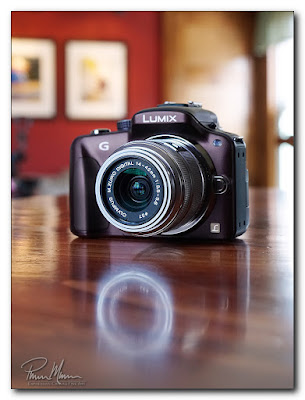Infrared Conversion
The short trip down to the Post Office and back was enough to do me in for the rest of the day though. Riding in a car, especially on the rougher than usual roads in the winter, is brutal. Riding in a car normally bothers my spinal injuries and often affects my Systemic Mastocytosis by agitating and activating my mast cells but yesterday's very short trip to the local Post Office was a painful ride due to my recent bone marrow biopsy. I was glad to be back home after this short trip.
I sent my small Panasonic Lumix G3 camera to a place on the west coast that specializes in infrared conversions. This conversion will allow my camera to record in the infrared wavelengths rather than the usual visible light wavelengths. To be more precise, I am having it converted to pick up light only in the wavelengths from 830nm and above. This should allow my camera to shoot very deep black and white images with a clarity that is unattainable with normal cameras recording in visible light.
I don't ever use this camera for photography anymore so I won't miss having it available for everyday "normal" shooting. It has been sitting on a shelf for years actually. I also chose this camera for this particular conversion because it is one of my smallest cameras. The small size will allow me to easily slip it into my camera bag with my everyday camera gear when we are out and about for our day-trips. Then, if I happen to see a scene that is ideal for infrared imaging, I can easily pull this small camera out of my bag.
Here is a photo of Lukey using this camera at three and a half years old...
This little camera fit well in Lukey's diminutive three year old hands! That is a pretty good indication of this camera's small size.
If I like this infrared conversion and find myself shooting landscapes and architecture in infrared more often, I will pick up a used full-frame Sony a7 to convert to infrared too. I already use a Sony a7 for visible light photography and I love that camera. It's tonal qualities amaze me every time I shoot some photos with it. The full frame sensor is also a plus. I know this camera would be spectacular for infrared photography, however, before I spend the money on purchasing a second Sony a7 (because I plan on keeping my original Sony a7), I figured it would be wise to test the waters with this old Panasonic Lumix G3 since I wasn't using it anyway. As I said, if I like infrared photography, then I might try to pick up another Sony a7 camera body for this purpose. The Sony a7 shoots significantly nicer and noticeably nicer images than the Panasonic G3.
All of my cameras are quite old. My digital cameras are between nine and 20 years old. My film cameras are upwards of 70 years old. I rarely ever purchase new camera gear. Most of the gear that I purchase simply is no longer available as new. I suppose I would prefer to purchase new gear but, quite often, that isn't possible due to availability as well as financial reasons.
I probably won't get my converted Panasonic G3 back into my hands until mid-April. Between the time it takes to ship to the west coast and back and the time to actually convert the camera, it should eat up approximately a month of time.
On the positive side, the leaves on the trees should be just beginning to bloom when I get the camera back. Having leaves on the trees is almost a prerequisite for infrared photography. The chlorophyll in the leaves really lights up in the infrared wavelengths which then renders the leaves as ghostly bright white in monochrome infrared photography.
Obviously, I'm sure I'll be sharing some photos from that converted camera after I have some time with it. In the meantime, I'll need some other photography project to keep my mind engaged. Maybe I'll dig through some old photos and share some of them...


Comments
Post a Comment